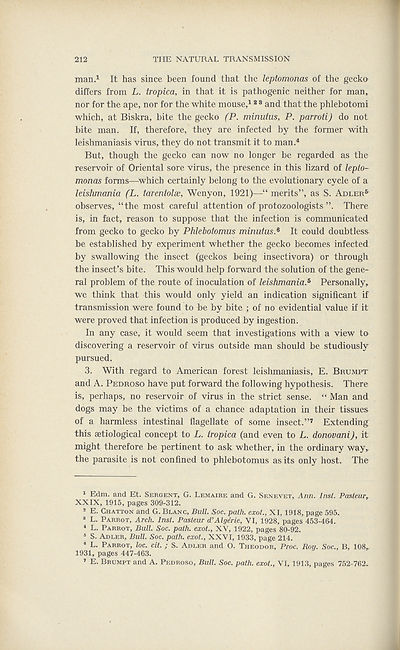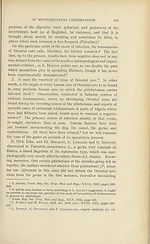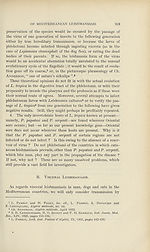Download files
Complete book:
Individual page:
Thumbnail gallery: Grid view | List view

212
THE NATURAL TRANSMISSION
man.1 2 3 It has since been found that the leptomonas of the gecko
differs from L. tropica, in that it is pathogenic neither for man,
nor for the ape, nor for the white mouse,12 3 and that the phlebotomi
which, at Biskra, bite the gecko (P. minutus, P. parroti) do not
bite man. If, therefore, they are infected by the former with
leishmaniasis virus, they do not transmit it to man.4
But, though the gecko can now no longer be regarded as the
reservoir of Oriental sore virus, the presence in this lizard of lepto¬
monas forms—-which certainly belong to the evolutionary cycle of a
leishmania (L. tarentolse, Wenyon, 1921)—“ merits”, as S. Adler5
observes, “the most careful attention of protozoologists”. There
is, in fact, reason to suppose that the infection is communicated
from gecko to gecko by Phlebotomus minutus.6 It could doubtless
be established by experiment whether the gecko becomes infected
by swallowing the insect (geckos being insectivora) or through
the insect’s bite. This would help forward the solution of the gene¬
ral problem of the route of inoculation of leishmania.6 Personally,
we think that this would only yield an indication significant if
transmission were found to be by bite ; of no evidential value if it
were proved that infection is produced by ingestion.
In any case, it would seem that investigations with a view to
discovering a reservoir of virus outside man should be studiously
pursued.
3. With regard to American forest leishmaniasis, E. Brumpt
and A. Pedroso have put forward the following hypothesis. There
is, perhaps, no reservoir of virus in the strict sense. “ Man and
dogs may be the victims of a chance adaptation in their tissues
of a harmless intestinal flagellate of some insect.”7 Extending
this setiological concept to L. tropica (and even to L. donovani), it
might therefore be pertinent to ask whether, in the ordinary way,
the parasite is not confined to phlebotomus as its only host. The
1 Edm. and Et. Sergent, G. Lemaire and G. Senevet, Ann. Inst. Pasteur,
XXIX, 1915, pages 309-312.
2 E. Chatton and G. Rlanc, Bull. Soc. path, exot., XI, 1918, page 595.
3 L. Parrot, Arch. Inst. Pasteur d’Algerie, VI, 1928, pages 453-464.
4 L. Parrot, Bull. Soc. path, exot., XV, 1922, pages 80-92.
5 S. Adler, Bull. Soc. path, exot., XXVI, 1933, page 214.
6 L. Parrot, loc. cit. ; S. Adler and O. Theodor, Proc. Rou. Soc., R, 108,
1931, pages 447-463.
7 E. Rrumpt and A. Pedroso, Bull. Soc. path, exot., VI, 1913, pages 752-762.
THE NATURAL TRANSMISSION
man.1 2 3 It has since been found that the leptomonas of the gecko
differs from L. tropica, in that it is pathogenic neither for man,
nor for the ape, nor for the white mouse,12 3 and that the phlebotomi
which, at Biskra, bite the gecko (P. minutus, P. parroti) do not
bite man. If, therefore, they are infected by the former with
leishmaniasis virus, they do not transmit it to man.4
But, though the gecko can now no longer be regarded as the
reservoir of Oriental sore virus, the presence in this lizard of lepto¬
monas forms—-which certainly belong to the evolutionary cycle of a
leishmania (L. tarentolse, Wenyon, 1921)—“ merits”, as S. Adler5
observes, “the most careful attention of protozoologists”. There
is, in fact, reason to suppose that the infection is communicated
from gecko to gecko by Phlebotomus minutus.6 It could doubtless
be established by experiment whether the gecko becomes infected
by swallowing the insect (geckos being insectivora) or through
the insect’s bite. This would help forward the solution of the gene¬
ral problem of the route of inoculation of leishmania.6 Personally,
we think that this would only yield an indication significant if
transmission were found to be by bite ; of no evidential value if it
were proved that infection is produced by ingestion.
In any case, it would seem that investigations with a view to
discovering a reservoir of virus outside man should be studiously
pursued.
3. With regard to American forest leishmaniasis, E. Brumpt
and A. Pedroso have put forward the following hypothesis. There
is, perhaps, no reservoir of virus in the strict sense. “ Man and
dogs may be the victims of a chance adaptation in their tissues
of a harmless intestinal flagellate of some insect.”7 Extending
this setiological concept to L. tropica (and even to L. donovani), it
might therefore be pertinent to ask whether, in the ordinary way,
the parasite is not confined to phlebotomus as its only host. The
1 Edm. and Et. Sergent, G. Lemaire and G. Senevet, Ann. Inst. Pasteur,
XXIX, 1915, pages 309-312.
2 E. Chatton and G. Rlanc, Bull. Soc. path, exot., XI, 1918, page 595.
3 L. Parrot, Arch. Inst. Pasteur d’Algerie, VI, 1928, pages 453-464.
4 L. Parrot, Bull. Soc. path, exot., XV, 1922, pages 80-92.
5 S. Adler, Bull. Soc. path, exot., XXVI, 1933, page 214.
6 L. Parrot, loc. cit. ; S. Adler and O. Theodor, Proc. Rou. Soc., R, 108,
1931, pages 447-463.
7 E. Rrumpt and A. Pedroso, Bull. Soc. path, exot., VI, 1913, pages 752-762.
Set display mode to:
![]() Universal Viewer |
Universal Viewer | ![]() Mirador |
Large image | Transcription
Mirador |
Large image | Transcription
Images and transcriptions on this page, including medium image downloads, may be used under the Creative Commons Attribution 4.0 International Licence unless otherwise stated. ![]()
| League of Nations > Health > Quarterly bulletin of the Health Organisation > Volume 3 > (220) |
|---|
| Permanent URL | https://digital.nls.uk/191559824 |
|---|
| Attribution and copyright: |
|
|---|---|
| Description | League of Nations |
|---|---|
| Shelfmark | LN.III.12.(1) |
| Shelfmark | LN.III |
|---|---|
| Description | Over 1,200 documents from the non-political organs of the League of Nations that dealt with health, disarmament, economic and financial matters for the duration of the League (1919-1945). Also online are statistical bulletins, essential facts, and an overview of the League by the first Secretary General, Sir Eric Drummond. These items are part of the Official Publications collection at the National Library of Scotland. |
|---|---|
| Additional NLS resources: |
|

